SUBJECTS
GRADE
Show Results
Shi' Naasha'

Lesson Summary
- Compare and contrast three versions of the Navajo song “Shí Naashá.”
- Write lyrics about how to personally find balance, peace, and harmony.
Lesson Plan and Procedure
Lesson Key Facts
- Grade(s): 3, 4, 5, 6
- Subject(s): English Language Arts, Health, Music, Social Studies, Native American, Tribe Approved
- Duration of lesson: Two sessions, 45 minutes each
- Author(s): Brenda Whitehorse and Emily Soderborg
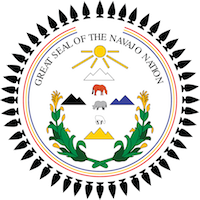
The Navajo Nation's Department of Diné Education, the education arm of the Navajo Nation, selected this lesson content in answer to the question, "What would you like the students of Utah to know about you?". Brenda Whitehorse, the Heritage Language Director for the San Juan School District, at the request of the Department of Diné Education, collaborated in crafting the lesson to provide expertise, accuracy, and authenticity. It was reviewed by the Navajo Nation Department of Diné Education’s Office of Diné School Improvement and Office of Standards, Curriculum, and Assessment. It was approved by the Navajo Nation Board of Education. The approval for publication was signed by the Navajo Nation President, Buu Nygren.
Before teaching this lesson, please explain to your students that there are many Native tribes in the United States and that this lesson specifically focuses on the Navajo Nation and does not represent other Native American groups. We hope other Native tribes will respect the Navajo Nation's choice to share this aspect of their culture.
Note: Not all Navajo songs are appropriate for students to sing in a classroom. Many are used in ceremonies and as prayers, and thus have specific requirements to be able to sing them, but “Shí Naashá” can be sung at any time of the year by anyone, even those that are not Diné.
Before teaching this lesson, spend the time necessary to become familiar with the resources included with this lesson. We will use the words Navajo and Diné interchangeably. Navajo is the common name, but members of the tribe continue to call themselves Diné (pronounced di-NEH). The following links provide excellent sound pronunciation as well as succinct information about the two words.
https://navajowotd.com/word/dineh/
https://americanindian.si.edu/nk360/navajo/long-walk/long-walk.cshtml
Session One: Emotions in Music
Teacher: I will ask you some questions to spark your thoughts and then give you one minute to respond with whatever answers come to mind. You may choose to respond to one prompt in depth, or you may respond to as many of these questions as you are able to in the one-minute time frame.
- What is the last piece of music you chose to listen to?
- How did the music make you feel?
- Did you listen to the music because of the mood you were in? Or, did you listen and have the music influence your mood?
- Describe what the music sounded like. (Singers, instruments, loud, soft, fast, slow, and so on.)
Give students one minute to write. Have students turn to a partner and share some of their responses.
Teacher: Music listening choices can represent a form of expression. Creating music is also a way people express themselves. There are many ways to express feelings through music. While music is often referred to as “the universal language,” the sounds of music vary greatly depending on the style of music, the culture the music comes from, the performer, the listener, and the intent for selecting or creating that song. We are going to compare and contrast some of these aspects in three recordings of the same song and then explore how we can also express ourselves with music.
Shí Naashá Background
Hand out the information page and 3-2-1 graphic organizer to each student.
Teacher: We will be listening to a song in the Navajo language. Before we listen, we will learn a little more about the people, culture, and history of this song. As we read through this information, we’ll use the 3-2-1 strategy. Listen for and record three things you learn, two things you find interesting, and one thing you still have a question about.
Teacher: The Navajo call themselves Diné, which means “the people.”
Listen to the pronunciation as a class.
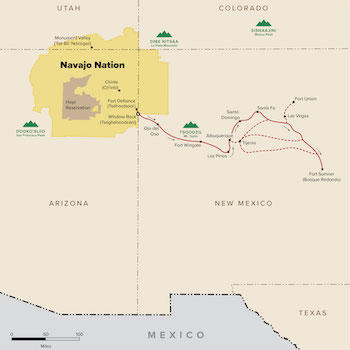
Teacher: We also refer to them as Navajo because that is the name given to them by Spanish settlers in the 1600s. We will use both terms interchangeably. The Diné live on land in between the four sacred mountains, called Diné Bikéyah (di-NEH bi-KEH-uh). The Navajo reservation, found in sections of northeastern Arizona, southeastern Utah, and northwestern New Mexico, occupies only part of this area between the four sacred mountains. It is the largest reservation in the United States, about the size of West Virginia. The Navajo Nation has the largest Native population in the United States with almost 400,000 enrolled members and over 165,000 living on the reservation itself.
Show a map of the Navajo Nation to give students context.
Teacher: In 1868, a treaty was signed between the Diné and the federal government to establish a sovereign nation known as the Navajo Nation. This gave the Navajo people the rights to self-governance and to establish government to government relations with the United States. Today the Navajo Nation continues to self-govern by operating their own schools, health care systems, and economy. The Navajo continue to preserve their rights to exercise and express their traditional ways. One way they do this is through song.
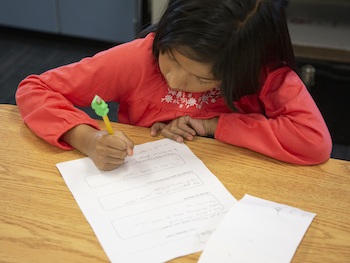
Teacher: The song we are going to listen to, called “Shí Naashá,” is one of the most well-known Navajo songs. Many Navajo songs are used in ceremonies and as prayers and have specific requirements to be able to sing them, but “Shí Naashá” can be sung at any time of the year by anyone, even those that are not Diné. “Shí Naashá” has historical significance. Between 1860 and 1864, settlers tried to take over the Diné homeland. The Diné were unwilling to leave their lands so American soldiers forcibly moved them by destroying their crops, homes, capturing livestock, and burning their lands. They eventually surrendered due to starvation and desperation. In 1864, the American military forced the Diné people to leave their homeland and walk 300 miles southeast to Bosque Redondo, New Mexico. Many lost their lives and suffered much due to hunger, cold, and lack of resources. Four years later, in 1868, they were allowed to return to their land. The words in “Shí Naashá” relate the joy of the people to finally be returning to the four sacred mountains. During the long walk home, upon finally seeing Mount Taylor (Tsoodził), the southern sacred mountain, they were overcome with happiness and began to sing “Shí Naashá.”
Give students one minute to fill out their 3-2-1 graphic organizer, then have students turn to a partner and share what they wrote. As a lesson extension, students could research answers to the questions they still have.
Listen and repeat how the Diné words were said.
Highlight on the map how far the Diné were forced to travel.
Analyzing “Shí Naashá”
Pass out a blank “Shí Naashá” analysis worksheet to each student.
Note: Before this section, you may consider going through a vocabulary development strategy with the music terms used in this activity: anchor chart, Marzano’s strategies (vocabulary), drawing, word wall.
Teacher: You will be listening to three Navajo artists sharing their rendition of Shí Naashá. As we listen to these recordings, there will be several things to pay attention to. These are listed in the left column. Timbre (pronounced ‘tam-bər) is the quality of a musical sound. That means using words to describe the sound. For instance, how would you describe the singer’s voice? Is it male or female? Here are some words you might use: strong, clear, light, breathy, full, thin, warm, dark, or nasal. Use as many words as you think describe the sounds. What instruments do you hear? What words would you use to describe the instruments’ sounds? Dynamics are how loud or soft the music is. Tempo is how fast or slow the music is performed, including if it speeds up or slows down. In the row labeled Imagery, you might draw something the music makes you imagine or write a question you have as you listen to the music. The final row is labeled Performer Intent. As you listen, try to figure out why this singer might be singing this song. Perhaps it is to entertain themselves or others, to teach the lyrics of the song to someone else, a lullaby to help others relax and sleep, to express emotions, or to reinforce ancient beliefs. These are just a few ideas to get you started. There could be lots of other possibilities. List as many ideas as you think fit.
Note: In the next section you will share different versions of this song with the class. Instead of showing these YouTube videos, simply listen to them, especially the Julia Begaye recording, as the artwork included is not an authentic or accurate representation of the Diné culture.

Listen to Kee Chee Jake from the album Navajo Songs from Canyon De Chelly. This recording contains multiple songs. “Shí Naashá” starts at the 1:51 time mark and goes to the 2:56 time mark. After listening to this recording, have the students work alone for a few minutes. Listen again and have students work with partners or small groups filling in the analysis sheet. If needed, listen a third time.
Continue by listening to a second version by Radmilla Cody from the album Shi Kéyah, and fill in the next column using the same procedures.
Finish by listening to Julia Begaye’s version from the album Under the Blue Corn Moon: Native American Lullabies. Fill in the final column.
After a few minutes of individual and partner work with the third recording, have students share their thoughts with the entire class.
Teacher: What was the same in each of these recordings? How did the singers express themselves differently, even though they were singing the same song? How could we use these same ideas to convey emotion in music we perform? Of the three recordings, which was your favorite? Why?
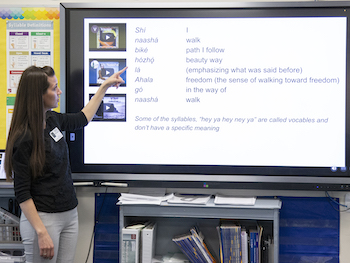
Learning the Song
The Diné transmit their songs orally, so the traditional way to learn music is to listen to the song again and again until those listening can sing it. Continuing with this pattern, listen to the lyrics spoken by Brenda Whitehorse, and have students repeat the words. This allows students the opportunity to form the words with their mouths before trying to sing them, especially if the language is not familiar. It is also important to realize that the lyrics in each of the recordings are slightly different, so practicing a specific way to say the words will help students as they start learning to sing the song.
There are three sections in the song: the vocables section (syllables that do not have a specific meaning), the shí naashá section, and the ahala section. One way to learn the song is to identify and practice each of these sections.
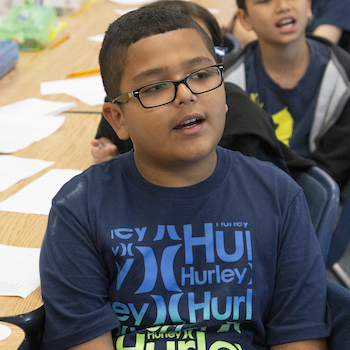
With this method, after the students have heard the entire song several times, have them learn the vocables (“hey ya hey ney ya”). These vocables are used to indicate the beginning and/or endings of different sections. See if they can sing along only on the vocable sections while listening to the entire recording. The Julia Begaye recording is the easiest one to sing along with, but as students feel comfortable, try it with any recording of “Shí Naashá.” Once the vocable section feels comfortable, identify and practice the repeated ahala phrase (“ahala, ahalá gó naashá”). Sing this section as well as the vocable section along with a recording. Finally, identify and practice the shí naashá section and then sing the entire song with a recording. Once students know the song, sing it with a drum keeping a steady beat or sing it a capella (without accompaniment).
Note: Another good sing along recording is a Smithsonian Folkways 1949 recording of Diné students singing at the Fort Wingate Charles H. Burke Indian School in New Mexico. This recording is helpful because students are able to hear others close to their age singing the song.
Session Two: Understanding “Shí Naashá”
Sing through “Shí Naashá” and assess how well students remember the melody and words. Determine if any parts of the song need additional support to learn.
Teacher: The words in “Shí Naashá” express the joy of the Diné to be returning to their homeland. While many other Navajo songs cannot be interpreted, almost every syllable in “Shí Naashá” is translatable.

Note: In the Navajo language, the language itself is connected to the sounds the people hear around them. The words could represent the sounds they hear in nature connected with the song, or actions of things they are doing, such as grinding corn. In this song, as they are walking, the words “ahala” can represent the sounds of walking, or the items they are carrying shifting around and going up and down in their bag as they walk. This is just one way the language represents what is heard.
Teacher: Remember that some of the syllables, “hey ya hey ney ya” are called vocables and don’t have a specific meaning. Here is a rough translation of the song:
Shí naashá, shí naashá, shí naashá biké hózhǫ́ lá
I am going, I am going, I am following the path; the way of beauty is around me.hey ya hey ney ya
vocables showing the end of the sectionAhala ahalá gó naashá, ahala ahalá gó naashá
Freedom, I am going in freedom. Freedom, I am going in freedom.Shí naashá, shí naashá, shí naashá biké hózhǫ́ lá
I am going, I am going, I am following the path; the way of beauty is around me.hey ya hey ney ya
vocables showing the end of the section
As an extension, for those wanting to learn additional Navajo words, you can learn the additional words Radmilla Cody sings (more descriptors).
Teacher: This song, as well as many other Navajo songs, refers to “walking in beauty” or “Hózhǫ́,” which is a Diné core belief and way of life. The beauty associated with the word “hózhǫ́” in Navajo does not refer to physical appearance. Instead, it roughly translates as the concept of balance, peace, harmony and beauty. This is the end goal for each Diné person. To walk in beauty also means to develop spiritual, emotional, physical, and mental strength to get beyond fears and be able to have joy, happiness, confidence, and peace.
Note: This video explains “hózhǫ́” in more detail. Consider sharing a portion of the video with students.
Personalizing “Shí Naashá”
Teacher: Each of us can also strive to find balance in our lives. How can you have happiness, confidence, and peace even when things are hard? What things can you do to help you walk in beauty? How do you manage and reduce stress in your life in healthy ways? Take a minute to think about these questions and write a few ideas down.
Teacher: We are each going to use the ideas we wrote down to create our own personal section of “Shí Naashá.” We will use the rhythm and melody from the “Ahala ahalá gó naashá” section. There are nine syllables in these words. You might decide to hold one of your syllables out longer or fit two syllables where only one is in the song. No matter what you decide, each person’s phrase will need to fit within the rhythm and melody of this section. As you try out words, you will also want to make sure that you stress the same syllables when singing that are stressed when speaking, so it sounds natural. Here are a couple of examples to get you brainstorming:
- I can take walks on a mountain trail.
- I can paint to express myself.
- I’ll go for a run to clear my mind.
- Having a dance party brings me joy.
- I’ll talk to someone I trust a lot.
Listen to the sample recording of these phrases interspersed between the Navajo words to hear how they can fit with the rhythm and melody of the “Ahala ahalá gó naashá” section from “Shí Naashá.”
Give students a few minutes to create their individual lyrics.
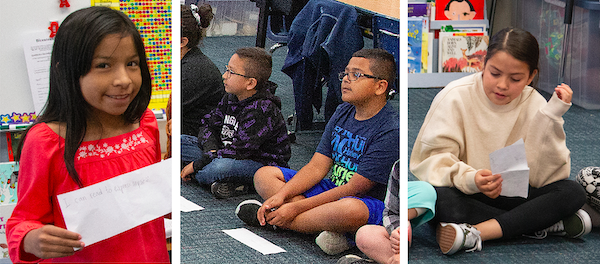
Teacher: Once you have written the lyrics for your phrase, sing it to yourself and make sure it fits within the rhythm and melody. After you have sung it on your own, find someone else who has also sung their own phrase and sing your phrases for each other.
Once all students have finished their phrase, invite them to sit in circle. Sing straight through “Shí Naashá,” either with a drum keeping a steady beat or acapella. After you have sung through the song once, sing through the song again, but this time, after the first “Ahala ahalá gó naashá” phrase, sing your own lyrics on the repeated phrase. Sing the “Ahala ahalá gó naashá” phrase again, and then have the student on your left sing their new phrase. Continue going back and forth between the Navajo “Ahala ahalá gó naashá” lyrics and the students’ original lyrics as the students take turns singing going clockwise around the circle. Once everyone has sung their lyrics, sing the original lyrics for “Shí Naashá” all the way through one more time.
Teacher: Take a moment to think about which new set of lyrics you heard today that stood out to you and why you thought that phrase was interesting. Turn and tell your neighbor your answer.
Teacher: Were there any ideas that others shared for finding “hózhǫ́” that you might like to try?
Teacher: As we learned this song, we learned a little about the history of the Diné people and about their culture that is still thriving today. As we learn about others, we are more able to empathize with them. Empathy is the ability to sense other people's emotions, as well as being able to imagine what someone else might be thinking or feeling. Can you imagine what it must have been like for the Navajo to be driven from their homes and forced to walk over 300 miles? Are there people today who are also facing hard things? How can you empathize with others today? How could the Diné way of viewing life help when facing those challenges? How has this song, which is all about walking in beauty, been used to express so many different kinds of emotions?
Listen as students discuss these questions.
Teacher: As we finish today, consider how you could share emotion through a song. Think of a song that might help you “walk in beauty.” What song would you use and why? How might you adjust the dynamics or tempos? What other ways could you express yourself through the music you choose? Will your version express peace, joy, unification, or something else?
Have students write down their ideas. As time allows, have them create their own arrangements of the song of their choice.
Learning Objectives
- Explore information about the Diné language and culture.
- Describe the timbre, dynamics, tempo, imagery, and performer’s intent for three pieces of music.
- Sing “Shí Naashá” accurately and in-tune.
- Compose new lyrics to express self.
- Identify healthy ways to manage stress.
Utah State Board of Education Standards
This lesson can be used to meet standards in many grades and subject areas. We will highlight one grade’s standards to give an example of application.
Grade 4 Music
- Standard 4.M.CR.4: Select and demonstrate musical ideas to express intent while connecting to purpose and context.
- Standard 4.M.P.1: Explain how the selection of music to perform is influenced by personal interest, purpose, context and knowledge and skills.
- Standard 4.M.P.2: Explore the effects of various dynamic levels, tempos, and articulations.
- Standard 4.M.P.4: Sing folk, traditional, and call-and-response songs in tune, with good vocal tone and clear diction.
- Standard 4.M.R.2: Recognize form, meter, beat versus rhythm, timbre, mood, dynamics, tempo, melody, texture and harmony/tonality.
- Standard 4.M.R.4: Describe feelings or imagery conveyed by a music selection.
- Standard 4.M.CO.1: Describe how music relates to personal, social, emotional, and intellectual development.
- Standard 4.M.CO.2: Draw upon interests, knowledge, and skills developed to inspire and inform the creation, performance, and appreciation of music, and deepen understanding of another content area through music.
- Standard 4.M.CO.3: Experience and explore music which connects us to history, culture, heritage, and community, and identify connections between a music genre and cultural or historical contexts.
Grade 4 Health Education
- Standard 4.MEH.1: Identify healthy ways to manage and reduce stress (for example, exercise, hobbies, mindfulness, time management, organization).
- Standard 4.MEH.3: Define empathy and practice demonstrating empathy with peers.
Grade 4 Social Studies
- Standard 4.2.3: Use primary and secondary sources to compare important aspects of the ways of life of at least two Native American tribal groups (for example, Ute, Paiute, Navajo (Diné), Shoshone, Goshute) existing within the land now called Utah and how those ways of life changed as settlers from Europe arrived prior to 1847.
- Standard 4.5.6: Choose one of Utah’s cultural institutions (for example Utah Symphony, The Tabernacle Choir at Temple Square, Utah Opera Company, Ballet West, Utah’s Shakespeare Festival, Utah Festival Opera), and explain its historical significance as well as the cultural benefits to Utah families and our nation.
Grade 4 English Language Arts
- Standard 4.SL.2: Clearly summarize information presented in various formats and media and explain how the information pertains to the topic.
Diné Standards
This lesson can be used to meet many Diné standards. The following are examples of application.
4th-6th Diné Character Building Standards
- Standard: K’ é hwiinidzin dóó ádáhozdílzin bee hadínísht’ée dooleełígíí bóhwiideesh’ááł.
I will develop and apply critical thinking to establish relationships with the environment.- Concept 2- Ádáhozdílzin.
I will maintain the sacredness of self-identity.- PO 1. Íínísts’ ą́ą’go binahjį’ bínashidi’neeztą́’ígíí choosh’į́į dooleeł.
I will listen to and apply Diné teachings. - PO 2. Hódzą’go íínánígíí bee nitséskeesgo naasháa dooleeł.
I will develop wise things in my personal life. - PO 4. Nitsáhákees hazhó’ó choosh’į́įgo bee yishááł dooleeł.
I will explain good judgements that I use to guide me.
- PO 1. Íínísts’ ą́ą’go binahjį’ bínashidi’neeztą́’ígíí choosh’į́į dooleeł.
- Concept 2- Ádáhozdílzin.
4th-6th Diné Culture Standards
- Standard: K’é dóó nitsáhákees dóó nahat’á náásgóó iiná bee siih hasingo ádoolnííł.
I will develop an understanding of Diné way of life.- Concept 1: Nitsáhá kees
Shintsáhákees shił nilį́į go bee ádaa ákonisdzin dool eeł.
I will acknowledge and value my thoughts and personality.- PO 1: Diné be’é’ooĺįįł bóhoosh’aahgo binahjį’ ádił nishdlį́į dooleeł.
I will develop my cultural knowledge to build self worth.
- PO 1: Diné be’é’ooĺįįł bóhoosh’aahgo binahjį’ ádił nishdlį́į dooleeł.
- Concept 1: Nitsáhá kees
4th-6th Diné Government Standards
- Standard: Diné Bi Beenahaz’áanii Atsé Siléí baa ákonisin dooleeł.
I will understand and apply the Navajo Nation Laws (Traditional Law, Customary Law, Natural Law and Common Law).- Concept 2: Diyin Dine’é Bits’ą́ą́dę́ę́’ Beehaz’áanii – Diné Customary Law:
Diyin Dine’é bits’ą́ą́dę́ę́’ beehaz’áanii náásgóó iiná bee ánísht’ée dooleełígíí bóhoosh’aah.
I will sustain myself through Diné teachings.- PO 1: Na’nitin yá’át’éhígíí nabíníshtaah dooleeł.
I will practice and follow the cultural teachings. - PO 2: Diné bina’nitin bee shaa áni’ dóó shintesékees bidziil dooleeł.
I will show ways to sustain my mental health through Diné teachings. - PO 3: Shitah hwiinéigo ádííníszinígíí baa hashne’ dooleeł.
I will describe ways to maintain a healthy lifestyle.
- PO 1: Na’nitin yá’át’éhígíí nabíníshtaah dooleeł.
- Concept 2: Diyin Dine’é Bits’ą́ą́dę́ę́’ Beehaz’áanii – Diné Customary Law:
4th-6th Diné History Standards
- Standard: Diné bibee’é’ool’įįł dóó ádahóót’įįdígíí shił nilį́įgo ádídíínísht’i’ dooleeł.
I will understand historical/factual events, people and symbols that influence my family.- Concept 3: Nihinaagóó bitsį’ yishtłizhii kéédahat’ínígíí dóó shidine’é bahane’ ahąąh naashnilgo baa hashne’ dooleeł.
I will compare and contrast major historical events of Diné and neighboring tribes.- PO 3: Diné daasnáá dóó ch’ééná yii’ tádookai y ígíí shił bééhóz in doo leeł.
I will identify the captivity and the hardship that affected Diné people.
- PO 3: Diné daasnáá dóó ch’ééná yii’ tádookai y ígíí shił bééhóz in doo leeł.
- Concept 4: Nihina’nitin,nihe’éool’įįł, dóó nihizaad nidaasya’ígíí náásgóó yilyéłígíí baa ákonisin dooleeł.
I will understand the integrity of my culture, language, and values that are protected and maintained by Diné.- PO 2: Shik’éí dinéhí nihe’é’ool’įįł yínida’niłtinígíí shił bééhózin dooleeł.
I will identify the teachings of Dine culture and history.
- PO 2: Shik’éí dinéhí nihe’é’ool’įįł yínida’niłtinígíí shił bééhózin dooleeł.
- Concept 3: Nihinaagóó bitsį’ yishtłizhii kéédahat’ínígíí dóó shidine’é bahane’ ahąąh naashnilgo baa hashne’ dooleeł.
Equipment and Materials Needed
- Slide presentation
- Sound files as examples for how to pronounce Navajo words:
- Blank paper or journal
- Pencils
- of Navajo Nation and route of Long Walk to Bosque Redondo
- Music recordings of “Shí Naashá ”:
- Kee Chee Jake on Navajo Songs from Canyon De Chelly
- Radmilla Cody on Shi Ké yah
- Julia Begaye on Under the Blue Corn Moon: Native American Lullabies
- Drum (optional)
- Video of Brenda Whitehorse pronouncing Shí Naashá lyrics
Additional Resources
This lesson was created thanks to a grant from the National Endowment for the Arts and the Utah Division of Arts & Museums.
- Navajo Nation website
- Music of the Sioux and the Navajo–Folkways recording (Fort Wingate Indian School, 1949) On this recording, “Shí Naashá” is titled “A Children’s Song: Song of Happiness”
- "Old Navajo Baby Songs" by Daybreakwarrior. This YouTube video includes another version of “Shí Naashá” that could also be used in this lesson.
- McCullough-Brabson, Ellen, and Marilyn Help. We'll Be in Your Mountains, We'll Be in Your Songs: a Navajo Woman Sings. Albuquerque, NM: University of New Mexico Press, 2002.
- Cheek, Lawrence W. The Navajo Long Walk. Tucson, AZ: Rio Nuevo Publishers, 2004.
- Bruchac, Joseph, and Shonto Begay. Navajo Long Walk: the Tragic Story of a Proud People's Forced March from Their Homeland. Washington, D.C.: National Geographic Society, 2002.
- https://navajotimes.com/reznews/hweeldi-150/
- https://americanindian.si.edu/nk360/navajo/long-walk/long-walk.cshtml
- The “Shí Naashá” recording by Kee Chee Jake would be appropriate to do the Round Dance to. See the Native American Round Dance lesson plan for more information.
Image References
Image 1: James Huston
Image 2: Navajo Nation Department of Diné Education
Image 3: Curtis Soderborg
Image 4: James Huston
Image 5: https://www.newworldrecords.org/products/navajo-songs-from-canyon-de-chelly?_pos=1&_sid=f9bc5c5fe&_ss=r&variant=31918358331471
Image 6: https://canyonrecords.com/product/radmilla-cody-shi-keyah-cr-6502/
Image 7: https://silverwaverecordsatrain.bandcamp.com/album/under-the-green-corn-moon
Images 8-12: James Huston
© Brigham Young University and Navajo Nation Department of Diné Education

www.education.byu.edu/arts/lessons
 Download
Download